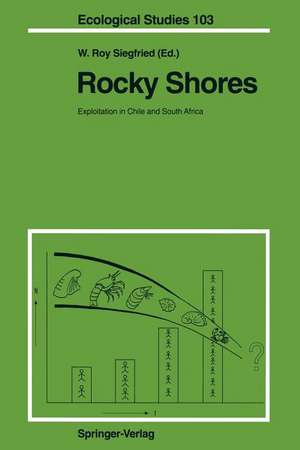Rocky Shores: Exploitation in Chile and South Africa: Ecological Studies, cartea 103
Editat de W. Roy Siegfrieden Limba Engleză Paperback – 16 dec 2011
Din seria Ecological Studies
- 18%
 Preț: 1118.93 lei
Preț: 1118.93 lei -
 Preț: 553.71 lei
Preț: 553.71 lei - 18%
 Preț: 1680.55 lei
Preț: 1680.55 lei - 18%
 Preț: 1003.38 lei
Preț: 1003.38 lei - 20%
 Preț: 1004.69 lei
Preț: 1004.69 lei -
 Preț: 480.62 lei
Preț: 480.62 lei - 5%
 Preț: 752.26 lei
Preț: 752.26 lei - 15%
 Preț: 643.99 lei
Preț: 643.99 lei - 15%
 Preț: 644.18 lei
Preț: 644.18 lei - 15%
 Preț: 652.49 lei
Preț: 652.49 lei - 18%
 Preț: 789.83 lei
Preț: 789.83 lei - 15%
 Preț: 643.48 lei
Preț: 643.48 lei - 15%
 Preț: 646.30 lei
Preț: 646.30 lei - 15%
 Preț: 634.32 lei
Preț: 634.32 lei -
 Preț: 384.86 lei
Preț: 384.86 lei - 18%
 Preț: 789.98 lei
Preț: 789.98 lei - 15%
 Preț: 645.14 lei
Preț: 645.14 lei - 15%
 Preț: 649.39 lei
Preț: 649.39 lei - 18%
 Preț: 1005.43 lei
Preț: 1005.43 lei - 18%
 Preț: 949.23 lei
Preț: 949.23 lei - 15%
 Preț: 649.54 lei
Preț: 649.54 lei - 15%
 Preț: 643.34 lei
Preț: 643.34 lei - 15%
 Preț: 649.71 lei
Preț: 649.71 lei - 15%
 Preț: 638.76 lei
Preț: 638.76 lei - 18%
 Preț: 957.62 lei
Preț: 957.62 lei - 18%
 Preț: 1235.25 lei
Preț: 1235.25 lei - 18%
 Preț: 962.18 lei
Preț: 962.18 lei - 18%
 Preț: 949.23 lei
Preț: 949.23 lei - 15%
 Preț: 660.68 lei
Preț: 660.68 lei -
 Preț: 397.76 lei
Preț: 397.76 lei - 15%
 Preț: 638.24 lei
Preț: 638.24 lei - 18%
 Preț: 942.31 lei
Preț: 942.31 lei - 18%
 Preț: 1232.57 lei
Preț: 1232.57 lei - 15%
 Preț: 651.34 lei
Preț: 651.34 lei - 18%
 Preț: 952.72 lei
Preț: 952.72 lei - 18%
 Preț: 1834.27 lei
Preț: 1834.27 lei - 18%
 Preț: 1229.10 lei
Preț: 1229.10 lei -
 Preț: 423.95 lei
Preț: 423.95 lei - 18%
 Preț: 948.92 lei
Preț: 948.92 lei
Preț: 382.36 lei
Nou
Puncte Express: 574
Preț estimativ în valută:
73.16€ • 76.59$ • 60.54£
73.16€ • 76.59$ • 60.54£
Carte tipărită la comandă
Livrare economică 05-19 aprilie
Preluare comenzi: 021 569.72.76
Specificații
ISBN-13: 9783642782855
ISBN-10: 364278285X
Pagini: 196
Ilustrații: XI, 177 p.
Dimensiuni: 155 x 235 x 10 mm
Greutate: 0.28 kg
Ediția:Softcover reprint of the original 1st ed. 1994
Editura: Springer Berlin, Heidelberg
Colecția Springer
Seria Ecological Studies
Locul publicării:Berlin, Heidelberg, Germany
ISBN-10: 364278285X
Pagini: 196
Ilustrații: XI, 177 p.
Dimensiuni: 155 x 235 x 10 mm
Greutate: 0.28 kg
Ediția:Softcover reprint of the original 1st ed. 1994
Editura: Springer Berlin, Heidelberg
Colecția Springer
Seria Ecological Studies
Locul publicării:Berlin, Heidelberg, Germany
Public țintă
ResearchCuprins
1 The Exploitation of Intertidal and Subtidal Biotic Resources of Rocky Shores in Chile and South Africa — An Overview.- 1.1 Introduction.- 1.2 Prehistorical and Historical Exploitation.- 1.3 Scope of Modern Exploitation.- References.- 2 Man as a Component of the Littoral Predator Spectrum: A Conceptual Overview.- 2.1 Introduction.- 2.2 Stability and Equilibria in Natural Systems.- 2.3 Co-evolution, Adaptation and Exaptation as Variables in Intertidal Predator-Prey Interactions.- 2.4 Characteristics of Human Predation in the Intertidal Zone.- 2.5 Consequences of Human Predation in the Intertidal Zone.- 2.6 Conclusions.- References.- 3 Seaweeds as Resources.- 3.1 Introduction.- 3.2 The Nature and Historical Development of Seaweed Industries.- 3.3 Ecological Effects of Seaweed Removal.- 3.4 General Patterns.- References.- 4 Intertidal and Subtidal Filter-Feeders in Southern Africa.- 4.1 Introduction.- 4.2 The Principal Filter-Feeders.- References.- 5 Intertidal and Subtidal Grazers.- 5.1 Introduction.- 5.2 The History of Modern Exploitation.- 5.3 Target Species.- 5.4 Direct Effects of Human Exploitation on the Target Species.- 5.5 The Value of Reserves.- 5.6 Changes in Density, Size and Intrinsic Attributes of Grazers.- 5.7 Indirect Interspecific Effects of Exploitation.- 5.8 Ripple Effects and Multispecies Fisheries.- 5.9 Overall Comparisons Between South Africa and Chile.- References.- 6 Exploitation of Two Critical Predators: The Gastropod Concholepas concholepas and the Rock Lobster Jasus lalandii.- 6.1 Introduction.- 6.2 Biology of the Loco.- 6.3 The Loco Fishery.- 6.4 Biology of the Rock Lobster.- 6.5 The Rock Lobster Fishery.- 6.6 The Effects of the Loco on Its Biotic Community.- 6.7 The Effects of the Rock Lobster on Its Biotic Community.- 6.8 ComparisonsBetween the Loco and the Rock Lobster.- 6.9 Alternative Stable States.- References.- 7 Biological Options for the Management of the Exploitation of Intertidal and Subtidal Resources.- 7.1 Introduction.- 7.2 The Vulnerability of Different Species.- 7.3 Objectives of Management.- 7.4 Techniques for Management.- 7.5 Problems Attending Management Methods.- 7.6 Functions of Reserves.- 7.7 Selection Criteria for Reserves.- References.- 8 Socio-Economic Options for the Management of the Exploitation of Intertidal and Subtidal Resources.- 8.1 Introduction.- 8.2 The Problem of Managing Intertidal Resources Through Legislation.- 8.3 Common-Property Exploitation in the Intertidal: A Certain Recipe for Disaster.- 8.4 From Common Property to Private Ownership: The Focus Shifts to Fewer Individuals.- 8.5 The Co-operative Option: Can Social Feedback Lead to Mutual Coercion and Self-Restraint?.- 8.6 Can a Co-operative Management Structure Lead to the Protection of Coastal Resources by Social Feedback?.- 8.7 Private Incentive in the Co-operative System.- 8.8 A Gentle Harvest.- 8.9 Coastal Marine Reserves.- 8.10 The Efficacy of Co-operatives.- 8.11 Conclusions.- References.- Index of Scientific Names.- Locality Index.















